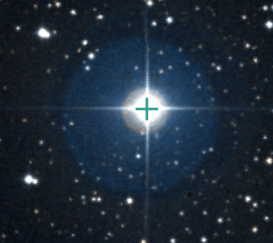Star of the Month
V640 Monocerotis
AKA: Plaskett’s star; HR 2422.
Position: 06 hrs 37 min 24.0 sec 06 degrees 08 min 08 sec
Due south at 20.55 (GMT) on 15 February
V640 Monocerotis
Image: Simbad (http://simbad.u-strasbg.fr/simbad/)
When Dover Publications published the three volumes of Robert Burnham Jr’s Celestial Handbook in 1968, it revolutionised amateur astronomy, especially in the USA. In Britain, Thomas Webb’s Celestial Objects for Common Telescopes remained popular, especially after Dover republished the final 1917 edition in 1962. In between these two major guides to the deep sky, there was another smaller book, Charles E. Barns’ 1001 Celestial Wonders as Observed with Home-built Instruments, published in 1929. It never displaced Webb’s book in Britain but it was popular in the USA. It is a very odd book: on the verso page you see a diagrammatic chart of a narrow strip of the sky and on the facing recto page you have very brief notes on the deep sky objects to be found in that strip, mostly double stars. But at the bottom of the page there are long footnotes which have nothing to do with the main text, such as “astronomical progress” or “no last word in astronomy”. The notes on the deep sky objects are usually tedious and practically cryptic, but on page 63, the text suddenly bursts into life – “Plaskett’s monster Double!” – and quotes James Jeans: “Most massive and absolutely the brightest star whose elements are known”.
This double gets its name from the Canadian astronomer John Stanley Plaskett from 1922 onwards. And it is certainly a whopper! The two O supergiant stars combined have a mass of 100 solar masses and it was considered to be the most massive binary star in existence, until it was shown around the turn of the present century that Eta Carinae – hitherto thought to be a single massive star – is in fact a binary with a combined mass of about 150 solar masses and with a far greater luminosity. The two stars in V640 Monocerotis are very close together, with an orbital period of only 14.4 days. The secondary is rapidly rotating with the usual equatorial bulge. As a result of these factors, the star is a variable (hence its designation as V640 Monocerotis), but the variation is very slight, only 0.1 of a magnitude over a few hours.
There is a great difference between the calculated luminosity of Plaskett’s star (about 350,000L☉) and that of Eta Carinae (about 6,000,000L☉), which led to speculation that the accepted distance to the star is incorrect. However the distance recently measured by Gaia – 4955 light years – is in keeping with previous measurements and commensurate with it being a member of the Monoceros OB2 association of massive O and B stars. To find this monster, it is almost exactly halfway between Procyon and Betelgeuse, and just to the north-east (or upper left) of the Rosette Nebula (see the DSO of the Month for January 2021). The magnitude is 6.1, so you will need binoculars or a small telescope to see it in Havering. The binary is a spectroscopic binary and cannot be seen visually. Being such massive stars, both of the stars in the system will have short lives which will end in a supernova. But what will happen next? Either the explosion of the larger star will expel its companion from the system, or they may stay together and eventually become binary neutron stars or even binary black holes which will presumably merge sooner or later and create a signal in the equivalent of LIGO in the remotely distant future.
